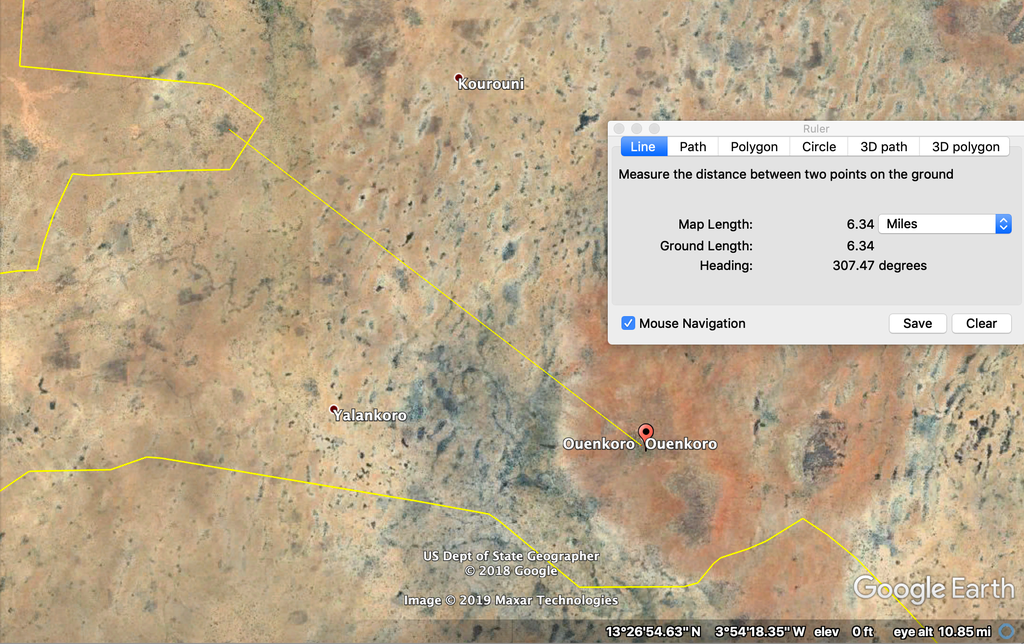Investigating Mali’s Raid into Burkina Faso
On Saturday, November 16th, Malian forces reportedly crossed the border between Mali and Burkina Faso and sacked a village. News reporting indicates that at least three people were killed while the village suffered serious damage and the remainder of the population fled to the district center.
Further investigation reveals that although the village was less than a kilometer from the border, the assailants did not simply “dismantle” an enemy base – they nearly flattened the village, burned homes, pulled down buildings, and killed livestock. Open-source information does not provide enough information to definitively conclude that the Malian government carried out the attack, but it does show that it is far more likely than not that the Malian military destroyed the village.
Locating the village in Burkinabe territory was difficult because initial reporting referred to the village as “Habaye”, not “Abaye”. After searching a cached version of Burkina Faso’s list of villages for variations of Habaye, I landed on Abaye village in Kombori district as a possible location. I narrowed it down by Googling around a bit and finally discovered a French Wikipedia page for Abaye village (791 residents) in Kombori district. In a truly insane stroke of luck, the page also provided coordinates: 13° 26′ 27″ North, 3° 54′ 07″ West:
Could this be the village sacked by the Malian military? Let’s have a closer look. Digging around on Facebook revealed two sets of invaluable photographs of the targeted village post-attack. Two photos of a unique building with a wall and spire in those sets of images were prime candidates for geolocation:
In fact, there’s a building that closely resembles the one seen in the social media photos in the center of Abaye:
From the second angle:
With those buildings geolocated, we can confirm that the village sacked on Saturday was Abaye village in Burkina Faso. However, the question of who attacked the village remains open. Was it a Dozo hunting group? A Fulani herding group? The Malian military? Or perhaps a terrorist group?
The Malian military is the likely culprit for three reasons. First, they tweeted on Saturday that they were operating in the Ouenkoro region of Mali which sits directly next to the Burkina Faso border and is only six miles away from Abaye. It’s conceivable that they made a brief foray across the border to attack the village in Burkinabe territory.

Secondly, Burkina Faso’s government wrote a letter to their Malian counterparts asking for them to repatriate civilians arrested in the raid on Abaye. Of course, that is not proof in itself, but it does point to a far greater likelihood of Malian government involvement in the attack.
Finally, a picture in the set of images posted on Facebook appears to show a piece of medium or heavy weaponry – perhaps even a helicopter-fired rocket:

Although I don’t know enough about weaponry to identify it, it does look more sophisticated and heavier than the rifles and small arms with which Dozo or Fulani groups typically equip themselves. Certainly, if it was a helicopter-fired rocket, that would virtually prove the Malian military’s involvement.
According to the French government, the militaries of G5 Sahel countries (including Mali and Burkina Faso) can pursue terrorists up to 50 kilometers across their neighbors’ borders. The raid on Abaye was well within the 50 kilometer strip but, judging from the photos of the burned village, blackened fields, and dead livestock, it did not target a terror group’s base. Instead, the Malian government likely used the G5 bylaws as cover for a revenge attack on Abaye, a Dozo village, after Dozo hunters attacked a Fulani herding village in Mali.
Either way, open-source evidence proves that a village in Burkina Faso was demolished, likely by the Malian military.



